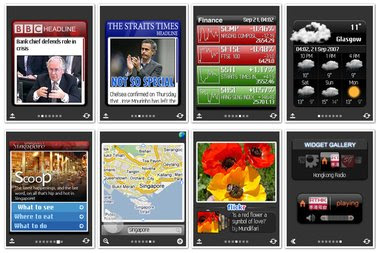

Emerging Mobile News
Mobile Widgets are taking over the mobile industry and will soon change the way we use our cell phones and mobile computing devices.
Less than a decade ago our phones changed from portable telephones into mobile computing platforms providing us with a variety of information at our fingertips.
This paradigm shift has changed the industry as it has changed carriers' strategies, attracted software and hardware companies, and even created its own standards for web development. The largest of carriers are changing policy, rate plans, and network access to accommodate the growing market.
Microsoft, Apple, Google,and others have millions of dollars invested in their mobile operating systems. Hardware manufacturers are finding new and innovative ways to make viewing and using our new mobile platforms more intuitive.
Only a short while ago Motorola was the dominant force in the market, now they are selling their handset division. Palm and the Palm OS used to dominate the mobile PDA OS space along with Mobile Widgets, now Palm ships many devices with Windows Mobile. Apple took the industry by storm with their foray into the mobile space with the iPhone, and once again Mobile Widgets changed.
Who will be the big players in the future? What is this year's Killer Application? How will Mobile Widgets change our daily lives? What platforms are strongest for development of Mobile Widgets?
How is developing for mobile platforms different than other application development? Mobile Widgets: Portable Applications on Mobile Platforms will address these questions and provide a foundation for understanding Mobile Widgets and the direction of developing applications on mobile platforms.
Select Report Findings
Mobile Widgets can be based upon hardware, native code, portable code, and web based applications WAP, WML, J2ME remain important but are often replaced with more traditional application development and web applications.
Mobile browsers are evolving to rival their desktop counterparts and increasingly include unique mobile capabilities.
Dynamic web technologies such as AJAX, Flash, and soon Silverlight, are finding their way into mobile platforms.
The ARM processor platform is currently the dominant processor architecture of today's smart phones. Successful Mobile Widgets no longer need to come from handset manufacturers or wireless carriers. The Mobile Widget market's growth rates and recent innovations are predicted to continue to grow. Mobile Widgets will continue to impact how carriers and hardware vendors do business.
Target Audience
Wireless Carriers: Carriers will want to understand the dynamics of mobile application development in order to ensure their networks can deliver what their subscribers need.
Mobile Handset Manufacturers: With innovative applications that leverage new hardware features of handsets, manufacturers will want to include features that leverage Mobile Widgets. Business Application Providers: Many of the highly successful Mobile Widgets target the mobile needs of business users.
Mobile Application Developers: The market is changing and even experienced developers will need to keep up with changes. Network Hardware Vendors: As the needs of mobile applications change, so will their demands on the networks that support them.
Marketing Professionals: The mobile market is a large resource for marketing that has great potential for mobile advertising.
Handset Accessory Manufacturers: Many Mobile Widgets leverage new hardware features of today's modern handsets that accessory manufacturers can extend with respect to device feature sets.
Web Developers: Soon many popular web sites will be accessed by thousands of mobile users. Web developers will need to know what those devices are capable of viewing and engaging content.
Mobility Data, Content, and Advertising Solution Providers: Mobile Widgets will be developed for markets as yet unrealized by the mobile industry.
Views: 66
Comments are closed for this blog post
© 2025 Created by Daniel Leuck.
Powered by
![]()